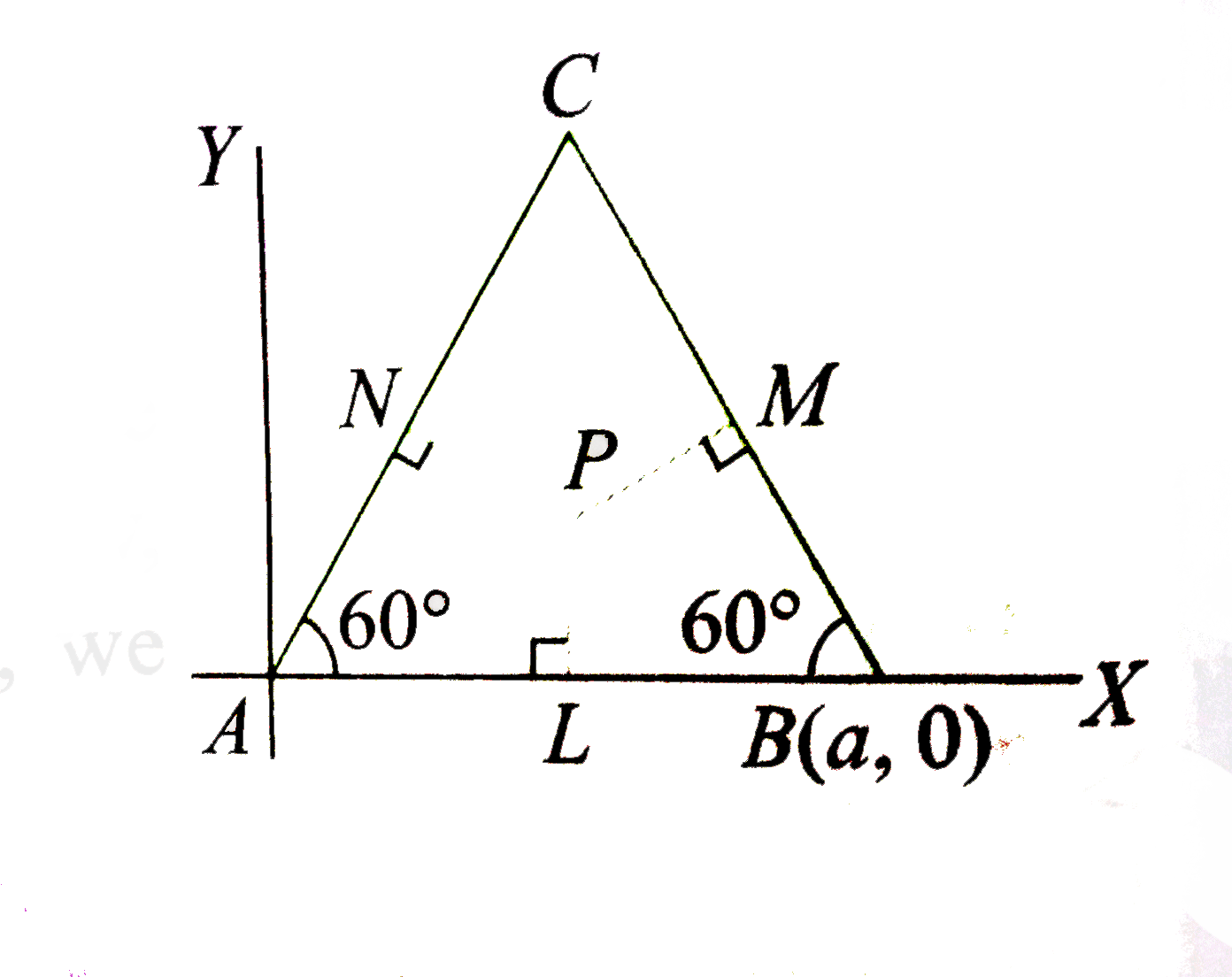ABC is an equilateral triangle with A(0,0) and B(a,0) , (a>0). L, M and N are the foot of the perpendiculars drawn from a point P to the side AB,BC,andCA , respectively. If P lies inside the triangle and satisfies the condition PL2=PM.PN, then find the locus of P.

The equations of lines AC and BC are, respectively, given by
y−√3x=0
y+√3(x−a)=0
Let P(h,k) be the coordinates of the point whose locus is to be found. Now, according to the given condition, we have
PL2=PM⋅PN
i.e.,k2=∣∣k−√3h∣∣2⋅∣∣k+√3(h−a)∣∣2
i.e.,4k2=(k−√3h)[k+√3(h−a)] [∵P lies below both the lines]
i.e.,3(h2+k2)−3ah+√3ak=0
i.e.,h2+k2−ah+a√3k=0
Putting (x,y) in place of (h,k) gives the equation of the required locus as
x2+y2−ax+a√3y=0
Topper's Solved these Questions
- STRAIGHT LINESBOOK - CENGAGECHAPTER - STRAIGHT LINESEXERCISE - Exercise 2.1
23 Videos
- STRAIGHT LINESBOOK - CENGAGECHAPTER - STRAIGHT LINESEXERCISE - Exercise 2.2
4 Videos
- STRAIGHT LINEBOOK - CENGAGECHAPTER - STRAIGHT LINEEXERCISE - Multiple Correct Answers Type
8 Videos
- THEORY OF EQUATIONSBOOK - CENGAGECHAPTER - THEORY OF EQUATIONSEXERCISE - JEE Advanced Previous Year
9 Videos
Similar Questions
ABC is an equilateral triangle with A(0,0) and B(a,0) , (a>0). L, M and N are the foot of the perpendiculars drawn from a point P to the side AB,BC,andCA , respectively. If P lies inside the triangle and satisfies the condition PL2=PM.PN, then find the locus of P.
View SolutionIn a triangle ABC if ∠A=θ and perpendiculars drawn from vertices B and C to respective opposite sides meet in P then find the value of ∠BPC in terms of θ.
View Solution
Knowledge Check
Let A(4,3),B(−4,3) and C(0,−5) be the vertices of triangle and P(5,0) let L,M and N be the feet of the perpendiculars drawn from P onto the sides BC,CA and AB respectively then
Aarea of ΔLMN is 5 sq. unitsBthe centroid of ΔLMN does not existCthe orthocentre of ΔLMN is the originDL,M and N are collinearLet ABC to be an acute triangle with BC=a,CA=bandAB=c, where a≠b≠c. From any point 'p' inside ΔABC≤tB,E,F denot foot of perpendiculars form 'p' noto the sides, BC, CA and AB, respectively. Now, answer the following equations.
Let (A(7,0),B(4,4)andC(0,0)andΔDEF is isosceles with DE=DF. Then, the curve on which 'P' may lieAx=4orx+yy=7or4x=3yBx=4orx2+y2=4x+4yC3(x2+y2)+196=49(x+y)DNone of the above
If BM and CN are the perpendiculars drawn on the sides AC and BC of the ΔABC, prove that the points B, C, M and N are concyclic.
View SolutionIn ΔPQR, if PQ=QR and L,M and N are the mid-points of the sides PQ,QR and RP respectively. Prove that LN=MN.

View SolutionOA and OB are fixed straight lines, P is any point and PM and PN are the perpendiculars from P on OAandOB, respectively. Find the locus of P if the quadrilateral OMPN is of constant area.
View SolutionLet O(0.0),A(6,0) and B(3,√3) be the vertices of △OAB. Let R those points P inside △OAB which satisfy d(P, OA) minimum (d(P,OB),d(P,AB) where d(P, OA), d(P, OB) and d(P, AB) represent the distance of P from the sides OA, OB and AFB respectively. If the area of region R is 9(a−√b) where a and b are coprime, then find the value of (a+ b)
View SolutionThe vertices of a triangle ABC are the points (0,b),(−a,0),(a,0). Find the locus of a point P which moves inside the triangle such that the product of perpendiculars from P to ABandAC is equal to the square of the perpendicular to BC.
View SolutionLet a point P lies inside an equilateral △ABC such that its perpendicular distances from sides are P1,P2,P3.If side length of △ABC is 2 unit then
View Solution
